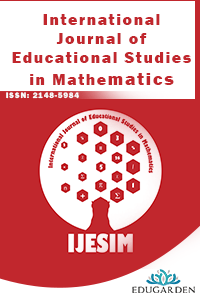Pre-Service Elemantary Mathematics Teachers’ Views On The Applicability Of Dynamic Geometry Black Box Activities In Classroom Environment
Pre-Service Elemantary Mathematics Teachers’ Views On The Applicability Of Dynamic Geometry Black Box Activities In Classroom Environment
The Dynamic Geometry (DG) software environment allows students to relate mathematical concepts, create conjectures, rationalize and use different strategies. The DG Environment offers the opportunity to design different activities from paper pencil environment activities thanks to the drag tool. One of these activities is “black box” activities. In this study, it is aimed to determine the pre-service teachers’ views regarding the applicability of black box activities in the classroom environment. A sample of the study on qualitative research has been made up of 10 pre-service teacher who have been studying in the last year of a State University's elementary mathematics teaching Bachelor's degree program. Data collected with two feedback forms prepared by the researcher were analyzed using content analysis method. As a result, it was found that the use of black box activities in classroom environment contributed to visualization, concretization and creative thinking within the frame of the pre-service teachers’ views.
Keywords:
Dynamic Geometry Black Box, Pre-Service Teachers,
___
- Baccaglini-Frank, A., & Mariotti, M. A. (2010). Generating conjectures in dynamic geometry: the maintaining dragging model. International Journal of Computer Mathematics, 15(3), 225-253.
- Barrera F., & Santos, M. (2001). Students' use and understanding of different mathematical representations of tasks in problem solving instruction. In R. Speiser, C. A. Maher, & C. N. Walter (Eds.), Proceedings of the Twentythird Annual Meeting of the North American Chapter of the International Group for the Psychology of Mathematics Education (pp. 449-456). Columbus, OH: ERIC Clearinghouse for Science, Mathematics, and Environmental Education.
- Büyüköztürk, Ş., Çakmak, E. K., Akgün, Ö. E., Karadeniz, Ş., & Demirel, F. (2014). Bilimsel araştırma yöntemleri. Ankara: Pegem A Akademi Yayınları.
- Elena, I. A., & Manuela, P. (2007). Dynamic environments as contexts for conjecturing and proving. International Journal of Engineering, 5(3), 7-13.
- Galindo, E. (1998). Assessing justification and proof in geometry classes taught using dynamic geometry software. Mathematics Teacher, 91(1), 76-82.
- Hölzl, R. (1996). How does "dragging" affect the learning of geometry. International Journal of Computers for Mathematical Learning, 1(2), 169–187.
- Jones, K., Mackrell, K., & Stevenson, I. (2010). Designing digital technologies and learning activities for different geometries. In C. Hoyles & J.-B. Lagrange (Eds.), Mathematics education and technology. Rethinking the terrain (pp. 47-60). Boston, MA: Springer.
- Komatsu, K., & Jones, K. (2018). Task design principles for heuristic refutation in dynamic geometry environments. International Journal of Science and Mathematics Education, 17(4), 1-24.
- Laborde, C. (2000). Dynamic geometry environments as a source of rich learning contexts for the complex activity of proving. Educational Studies in Mathematics, 44(1-3), 151-161.
- Laborde, C. (2001). Integration of technology in the design of geometry tasks with cabri-geometry. International Journal of Computers for Mathematical Learning, 6(3), 283–317.
- Leung, A. (2008). Dragging in a dynamic geometry environment through the lens of variation. International Journal of Computer Mathematics, 13(2), 135–157.
- Leung, A. (2011). An epistemic model of task design in dynamic geometry environment. ZDM Mathematics Education, 43(3), 325–336.
- Leung, A., & Lee, A. S. (2014). Students’ geometrical perception on a task-based dynamic geometry platform. Educational Studies in Mathematics, 82(3), 361–377.
- Mariotti, M. A. (2000). Introduction to proof: the mediation of a dynamic software. Educational Studies in Mathematics, 44(1-3), 25-53.
- Mogetta, C., Olivero, F., & Jones, K. (1999). Designing dynamic geometry tasks that support the proving process. Proceedings of the British Society for Research into Learning Mathematics, 4(3), 97-102.
- National Council of Teachers of Mathematics [NCTM]. (2000). Principles and standards for school mathematics (Executive Summary). Retrieved from https://www.nctm.org/uploadedFiles/Standards_and_Positions/PSSM_ExecutiveSummary.pdf
- Noss, R., & Hoyles, C. (1996). Tools and technologies. In R. Noss & C. Hoyles (Eds.), Windows on mathematical meanings (pp. 52-73). London: Springer, Dordrecht.
- Trigo, M. S., & Perez, H. E. (2002). Searching and exploring properties of geometric configurations using dynamic software. International Journal Math Education Science Technology, 1(1), 37-50.
- Yıldırım, A., & Şimşek, H. (2011). Sosyal bilimlerde nitel araştırma yöntemleri. Ankara: Seçkin Yayıncılık.
- Yayın Aralığı: Yılda 4 Sayı
- Başlangıç: 2014
- Yayıncı: Ercan MASAL
